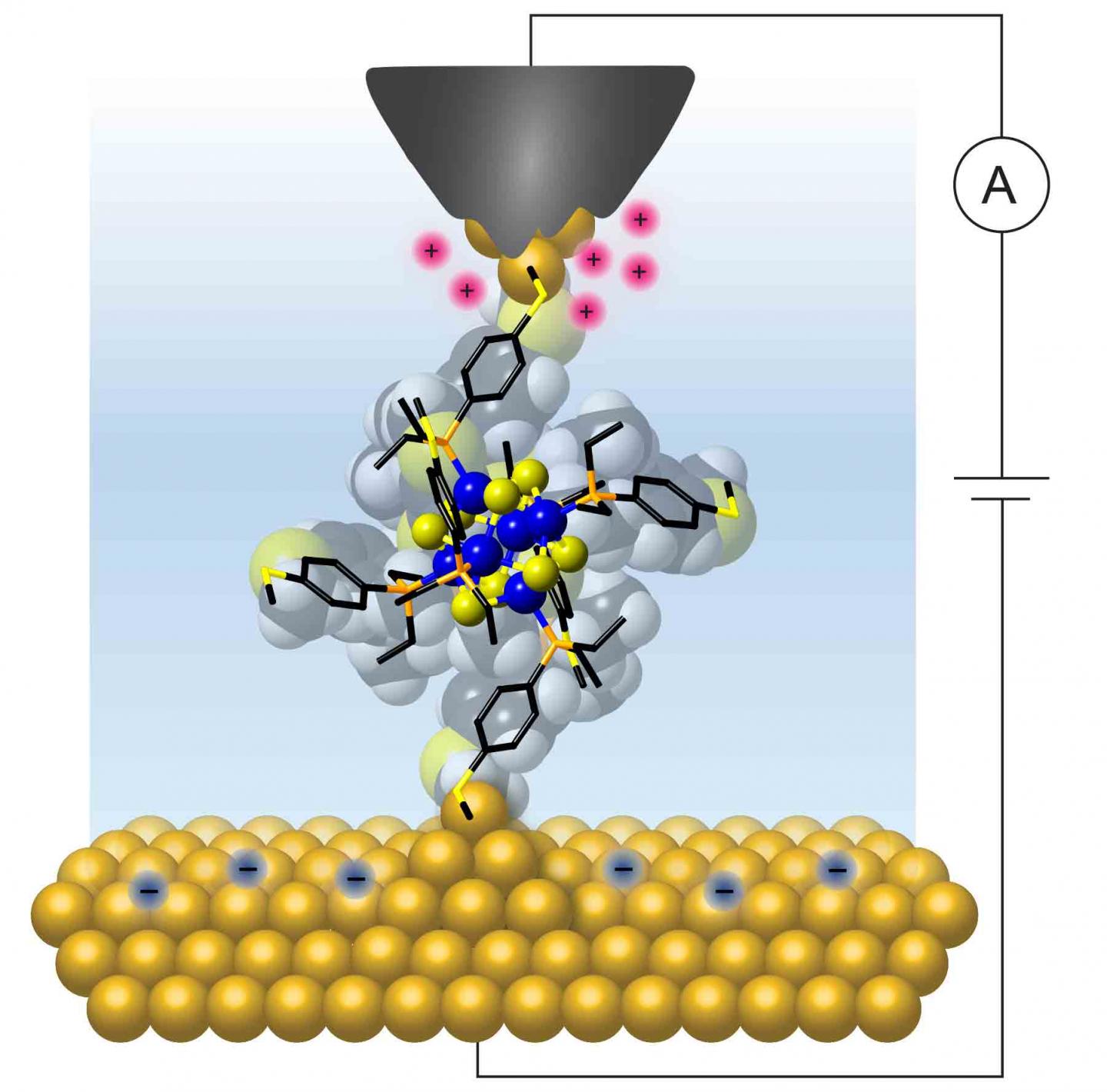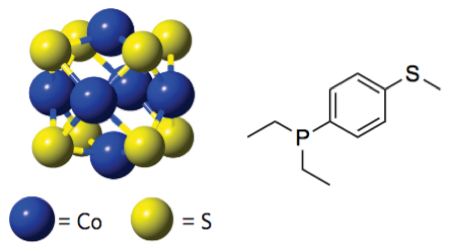A single-molecule room-temperature transistor made from 14 atoms
September 1, 2017

Columbia researchers wired a single molecule consisting of 14 atoms connected to two gold electrodes to show that it performs as a transistor at room temperature. (credit: Bonnie Choi/Columbia University)
Columbia Engineering researchers have taken a key step toward atomically precise, reproducible transistors made from single molecules and operating at room temperature — a major goal in the field of molecular electronics.
The team created a two-terminal transistor with a diameter of about 0.5 nanometers and core consisting of just 14 atoms. The device can reliably switch from insulator to conductor when charge is added or removed, one electron at a time (known as “current blockade”).*
The research was published in the journal Nature Nanotechnology.
Controllable structure with atomic precision
“With these molecular clusters, we have complete control over their structure with atomic precision and can change the elemental composition and structure in a controllable manner to elicit certain electrical response,” says Latha Venkataraman, leader of the Columbia research team.
The researchers plan to design improved molecular cluster systems with better electrical performance (such as higher on/off current ratio and different accessible states) and increase the number of atoms in the cluster core, while maintaining the atomic precision and uniformity of the compound.
Other studies have created quantum dots to produce similar effects, but the dots are much larger and not uniform in size, and the results have not been reproducible. The ultimate size reduction would be single-atom transistors, but they require ultra-cold temperatures (minus 196 degrees Celsius in this case, for example).

The single molecule’s 14-atom core structure comprises cobalt (blue) and sulfur (yellow) atoms (left) and ethyl-4-(methylthio)phenyl phosphine atoms, used to wire the cluster into a junction (right). (credit: Bonnie Choi/Columbia University)
* The researchers used a scanning tunneling microscope technique that they pioneered to make junctions comprising a single cluster connected to the two gold electrodes, which enabled them to characterize its electrical response as they varied the applied bias voltage. The technique allows them to fabricate and measure thousands of junctions with reproducible transport characteristics. The team worked with small inorganic molecular clusters that were identical in shape and size, so they knew exactly — down to the atomic scale — what they were measuring. The team evaluated the performance of the diode by the on/off ratio — the ratio between the current flowing through the device when it is switched on and the residual current still present in its “off” state. At room temperature, they observed a high on/off ratio of about 600 in single-cluster junctions, higher than any other single-molecule devices measured to date.
Abstract of Room-temperature current blockade in atomically defined single-cluster junctions
Fabricating nanoscopic devices capable of manipulating and processing single units of charge is an essential step towards creating functional devices where quantum effects dominate transport characteristics. The archetypal single-electron transistor comprises a small conducting or semiconducting island separated from two metallic reservoirs by insulating barriers. By enabling the transfer of a well-defined number of charge carriers between the island and the reservoirs, such a device may enable discrete single-electron operations. Here, we describe a single-molecule junction comprising a redox-active, atomically precise cobalt chalcogenide cluster wired between two nanoscopic electrodes. We observe current blockade at room temperature in thousands of single-cluster junctions. Below a threshold voltage, charge transfer across the junction is suppressed. The device is turned on when the temporary occupation of the core states by a transiting carrier is energetically enabled, resulting in a sequential tunnelling process and an increase in current by a factor of ∼600. We perform in situ and ex situ cyclic voltammetry as well as density functional theory calculations to unveil a two-step process mediated by an orbital localized on the core of the cluster in which charge carriers reside before tunnelling to the collector reservoir. As the bias window of the junction is opened wide enough to include one of the cluster frontier orbitals, the current blockade is lifted and charge carriers can tunnel sequentially across the junction.